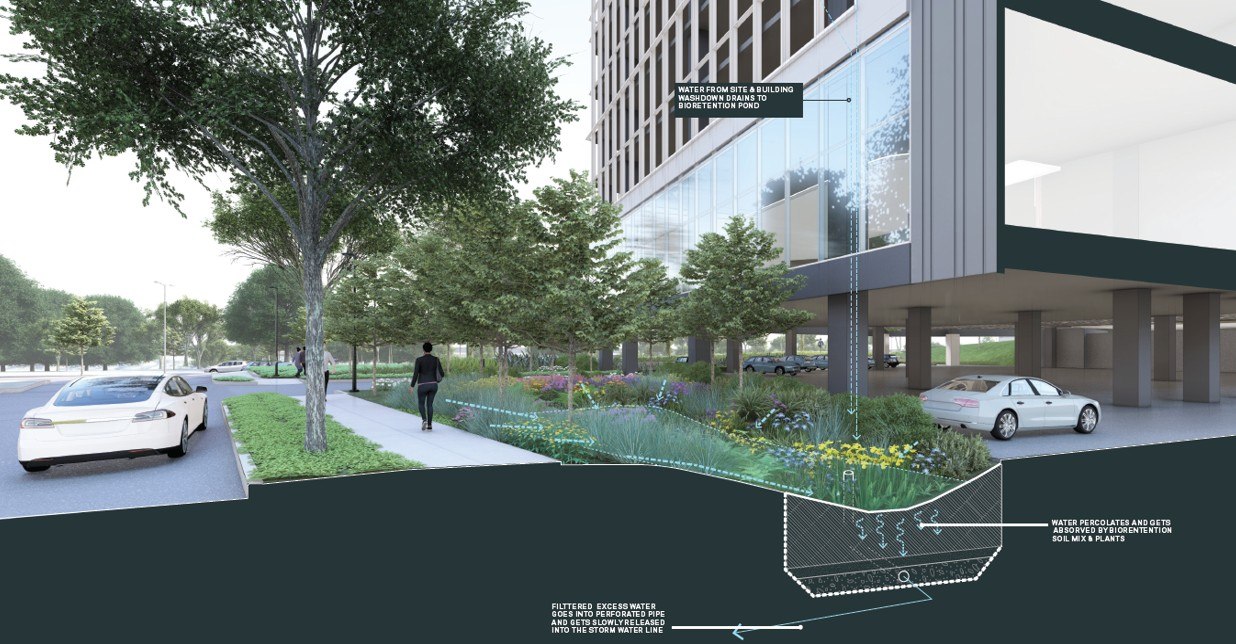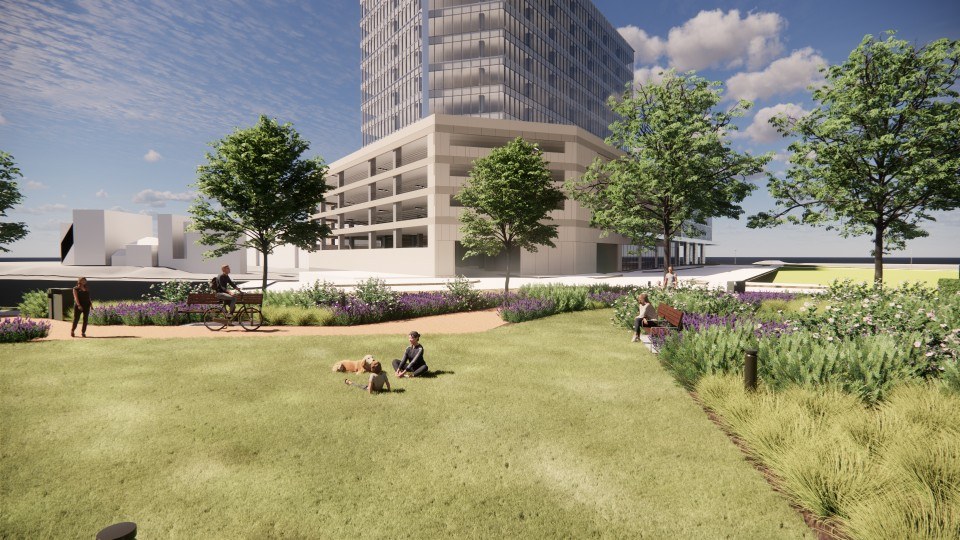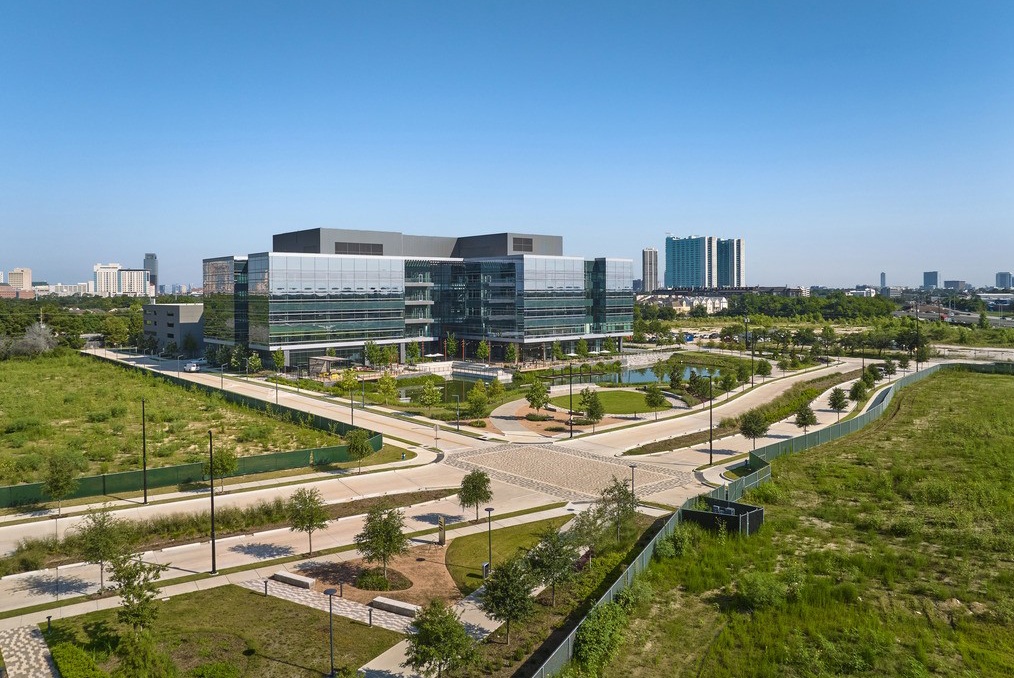Houston’s flood statistics tell a stark story: three “500-year” floods in just 24 years—Tropical Storm Allison (2001), the Memorial Day Flood (2015) and Hurricane Harvey (2017). Recognizing this alarming trend, NOAA had already begun updating its rainfall probabilities document, Atlas 14, which was released in 2018. This frequency forced city and county officials to recognize that these are no longer rare events and implement aggressive new standards. Stormwater detention requirements nearly doubled, and the no-net-fill in the floodplain rule prevent developments from exporting flood risk on their sites to neighboring properties.
Instead of viewing these flood resilience requirements as hurdles, design teams can leverage them to create projects that protect investments, enhance property values and deliver measurable community benefits.
Project Green: Flood Protection Meets Public Amenity
Project Green, a confidential headquarters tower along Houston’s Buffalo Bayou waterfront, demonstrates how developers can turn flood challenges into assets. The client chose to redevelop the lowest, most flood-prone portion of its expanded campus first, embracing the city’s no-net-fill in the floodplain rule rather than avoiding it. The design response excavates beneath the new tower, converting the lowest parking level into intentional flood storage. During a severe flood event, this area safely provides up to 15 feet of floodplain storage without impacting the offices and amenities above.

Section cut shows how the lowest parking level is designed to fill with floodwater, protecting offices above.
The project didn’t just mitigate risk. It also improved the neighborhood by rerouting and upgrading a city storm sewer through the property and installing an inline regional detention pond sized for nearby areas. These improvements increased the protection from a system with less than a two-year capacity to one with a 100-year capacity. To offset a portion of the construction cost, Houston’s Tax Increment Reinvestment Zone agreed to reimburse the owner for these upgrades. Bioretention gardens were integrated into the site drainage and landscape design to slow and clean stormwater runoff before it enters Buffalo Bayou. Topping the underground detention vault, a small community park now replaces the former asphalt parking lot, providing shared green space for the neighborhood.

A former asphalt parking lot becomes a public greenspace where neighbors can gather atop an underground detention vault.
Levit Green: Turning Stormwater into a District Feature

Levit Green’s first phase frames a one-acre lake that manages stormwater while elevating Houston’s life sciences hub.
Just south of downtown Houston, the 53-acre Levit Green life sciences campus faced even tougher challenges. Initially, each building parcel was required to manage its own stormwater independently. Through close collaboration with city officials, the design team transformed these fragmented requirements into a district-wide solution, concentrating stormwater management along the edges of the site.

Paths, plantings and café terraces turn functional basins into everyday gathering spots.
The result is a series of attractive, landscaped basins designed as one-acre lakes. Each lake includes up to four feet of storage above typical storm levels, creating a safe buffer against flooding. Beyond managing storms, these lakes serve as a constant irrigation source for the campus landscape. A specially designed central roadway with a reverse crown directs rainfall into landscaped swales in the median. This Low Impact Development (LID) strategy helps filter stormwater and makes the project eligible for city tax incentives.
Because the site sits under a flight path, and ponds tend to attract migrating birds such as geese and ducks, the team coordinated with the Federal Aviation Administration to mitigate bird-strike risk while preserving open water. This is another example of regulation informing, not constraining, design.
From Compliance to Competitive Advantage
 Design teams looking to turn regulatory pressures into long-term portfolio resilience can apply four related principles:
Design teams looking to turn regulatory pressures into long-term portfolio resilience can apply four related principles:
1. Position stormwater storage as amenities like parks or scenic lakes that enhance property values and leasing appeal.
2. Design spaces like parking garages and landscaped areas to safely flood first, protecting critical facilities.
3. Repurpose stored water for irrigation, cooling systems and other beneficial uses.
4. Leverage partnerships and public funding to maximize project benefits, securing reimbursements and grants that support sustainable neighborhood growth.
These approaches transform compliance into competitive advantage. Projects lease faster and protect long-term value while becoming resilient community anchors.
The Integration Advantage
Successful implementation requires planners, architects, landscape architects, engineers and sustainability specialists to collaborate closely, blending stormwater modeling with economic analysis. HOK’s integrated approach for these projects, in partnership with civil engineering firm Walter P Moore, quantifies how strategic flood management enhances rentable space, elevates project branding and improves financial performance.
Demonstrating measurable benefits is essential for gaining support from both regulators and investors. At Project Green, the business case convinced the client to tackle the most challenging, flood-prone parcel first rather than avoiding it. For Levit Green, quantified benefits helped secure city approval for the district-wide drainage plan and positioned the campus for accelerated future development.
What’s Next: Regulations Keep Tightening
The next national rainfall update—NOAA Atlas 15—is scheduled for release in 2026-27. Early pilot data has been released for Montana, and updated precipitation standards historically tend to be more stringent than previous versions. Local drainage codes will almost certainly ratchet up again once the full dataset is published. Designing to anticipated future standards now, instead of waiting for mandates to catch up, can spare owners the cost of retrofits and position assets for better longer-term insurability.
Building for Tomorrow’s Storms
Cities nationwide can look to Houston’s innovative approach as a potential national model for flood resilience. The takeaway for developers and urban planners is clear: Early collaboration with regulators and thoughtful integration of stormwater infrastructure into community spaces creates more resilient, valuable developments.
Acknowledgments: HOK collaborated with civil engineering firm Walter P Moore and developer Hines on the innovative site design approaches for the projects featured in this article.
Zachary Christeson, ASLA, PLA, LEED AP, leads HOK’s planning, urban design and landscape architecture practice in Texas. To explore resilient strategies tailored to your campus or district, contact him at zachary.christeson@hok.com.